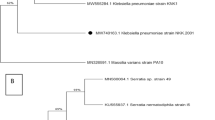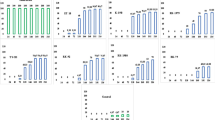Abstract
A search for means of biologically controlling the red palm weevil (RPW) Rhynchophorus ferrugineus resulted in the isolation of several microbial cultures belonging to bacteria, actinomycetes and fungi. Among the obtained cultures, three potent spore-forming bacilli were further isolated from natural habitats associated with insect-damaged date palms in Egypt. The isolated bacterial cultures, (strains 73, 15 and 27) were identified as variants of Bacillus sphaericus, B. megaterium and B. laterosporus, respectively. Under standard bioassay conditions, the mortalities of the second-instar larvae of the target insect induced by the three isolated bacilli variants ranged between 40 and 60%. The most active culture (strain no. 73) was identified as B. sphaericus. This isolate formed spherical endospores and crystalline endotoxin comparable to those of B. sphaericus standard strain 2362, which is pathogenic to mosquito larvae, as shown by electron microscopy. However, the amino acid composition of the spore-endotoxin complexes was markedly different.


Similar content being viewed by others
References
Abraham VA, Kurian C (1973) Chelisoches moris F. a predator on egg and early instar grubs of red palm weevil, Rhynchophorus ferrugineus F. J Plant N Crops (suppl.) 1:147–152
Bunerjee A, Dangar TK (1995) Pseudomonas aeruginosa, a facultative pathogen of red palm weevil, Rhynchophorus ferrugineus. World J Microbiol Biotechnol 11, 618–620
Cox ML (1993) Red palm weevil (Rhynchophorus ferrugineus), in Egypt. FAO. Plant Protec Bull 41:30–31
Dangar TK (1997) Infection of red palm weevil, Rhynchophorus ferrugineus, by a yeast. J. Plant Crop 25:193–196
El-Ezaby F (1997) A biological in-vitro study on the red Indian date palm weevil. Arab J Plant Protec 15:84–87
Gopinadhan PB, Mohandas M, Vasudevan, Nair KP (1990). Cytoplasmic polyhedrosis virus infecting red palm weevil of coconut. Curr Sci 59:577–580
Gordon RE (1974) The genus Bacillus. In: Laskin AI, Lechevalie HA (eds) Handbook of microbiology, vol 1. Organisms in Microbiology
Guerineau M, Alexander B, Priest FG (1991) Isolation and identification of Bacillus sphaericus strains pathogenic for mosquito larvae. J Invert Pathol 57.325–333
Murphy ST, Briscoe BR (1999) The red palm weevil as an olien invasive: biology and the prospects for biological control as a component of IPM. Biocontrol news and information 20:35N–46N
Winder K, Eggum OB (1966) Protein hydrolysis. A description of the method used at the department of animal physiology in Copenhagen. Acta Agric Scand 16:115
Acknowledgements
The authors thank the Egyptian Academy of Scientific Research and Technology for funding this research.
Author information
Authors and Affiliations
Corresponding author
Rights and permissions
About this article
Cite this article
Salama, H.S., Foda, M.S., El-Bendary, M.A. et al. Infection of red palm weevil, Rhynchophorus ferrugineus, by spore-forming bacilli indigenous to its natural habitat in Egypt. J Pest Sci 77, 27–31 (2004). https://doi.org/10.1007/s10340-003-0023-4
Received:
Published:
Issue Date:
DOI: https://doi.org/10.1007/s10340-003-0023-4




